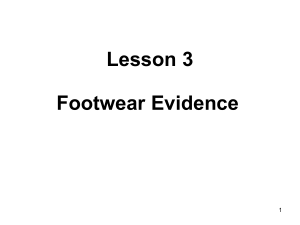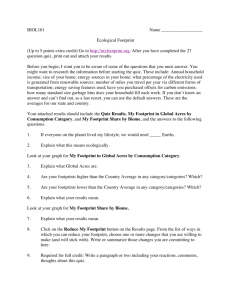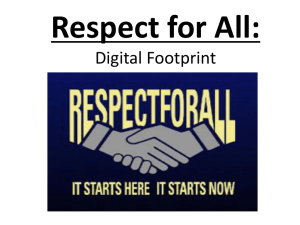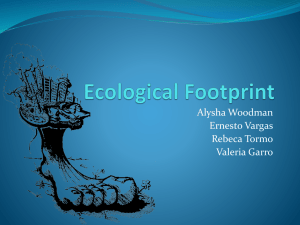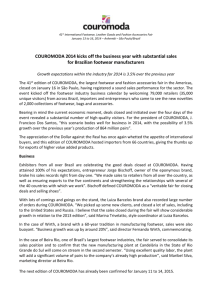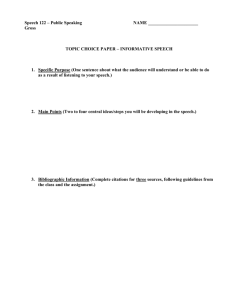Footwear Impressions
advertisement
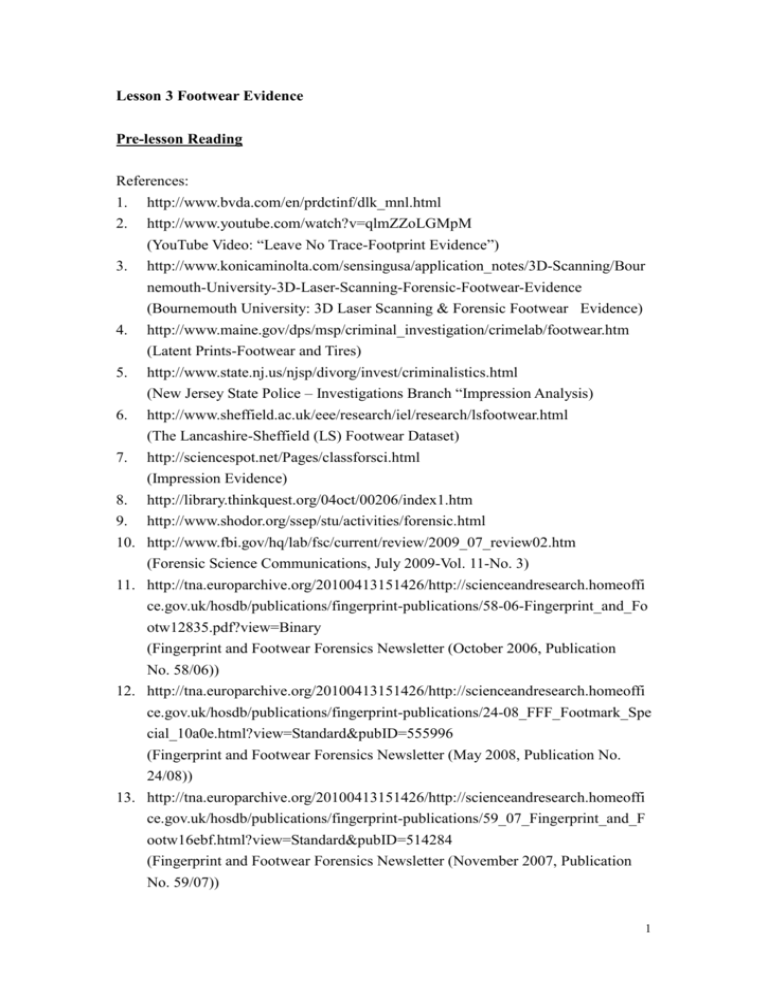
Lesson 3 Footwear Evidence Pre-lesson Reading References: 1. http://www.bvda.com/en/prdctinf/dlk_mnl.html 2. http://www.youtube.com/watch?v=qlmZZoLGMpM (YouTube Video: “Leave No Trace-Footprint Evidence”) 3. http://www.konicaminolta.com/sensingusa/application_notes/3D-Scanning/Bour nemouth-University-3D-Laser-Scanning-Forensic-Footwear-Evidence (Bournemouth University: 3D Laser Scanning & Forensic Footwear Evidence) 4. 5. 6. 7. 8. 9. http://www.maine.gov/dps/msp/criminal_investigation/crimelab/footwear.htm (Latent Prints-Footwear and Tires) http://www.state.nj.us/njsp/divorg/invest/criminalistics.html (New Jersey State Police – Investigations Branch “Impression Analysis) http://www.sheffield.ac.uk/eee/research/iel/research/lsfootwear.html (The Lancashire-Sheffield (LS) Footwear Dataset) http://sciencespot.net/Pages/classforsci.html (Impression Evidence) http://library.thinkquest.org/04oct/00206/index1.htm http://www.shodor.org/ssep/stu/activities/forensic.html 10. http://www.fbi.gov/hq/lab/fsc/current/review/2009_07_review02.htm (Forensic Science Communications, July 2009-Vol. 11-No. 3) 11. http://tna.europarchive.org/20100413151426/http://scienceandresearch.homeoffi ce.gov.uk/hosdb/publications/fingerprint-publications/58-06-Fingerprint_and_Fo otw12835.pdf?view=Binary (Fingerprint and Footwear Forensics Newsletter (October 2006, Publication No. 58/06)) 12. http://tna.europarchive.org/20100413151426/http://scienceandresearch.homeoffi ce.gov.uk/hosdb/publications/fingerprint-publications/24-08_FFF_Footmark_Spe cial_10a0e.html?view=Standard&pubID=555996 (Fingerprint and Footwear Forensics Newsletter (May 2008, Publication No. 24/08)) 13. http://tna.europarchive.org/20100413151426/http://scienceandresearch.homeoffi ce.gov.uk/hosdb/publications/fingerprint-publications/59_07_Fingerprint_and_F ootw16ebf.html?view=Standard&pubID=514284 (Fingerprint and Footwear Forensics Newsletter (November 2007, Publication No. 59/07)) 1 14. Bodziak, W.J. (1999). Footwear Impression Evidence: Detection, Recovery, and Examination) (2nd ed.). Florida: CRC Press. 2 Lesson 3 Footwear Evidence Worksheet 3.1 Introduction of footwear evidence Footwear impressions are often discovered at the scene of the crime. This evidence can provide investigators with certain information that can assist them in locating a suspect. Sample footprint Discuss with your group members “What are the important features in footprints and their significance (refer to the given example)?”: e.g. important features significance Size of footprint Real size of suspect’s foot height of suspect 1 2 3 4 5 3 Worksheet 3.2 Photographing footprints Taking photographs for footprints are very common in a crime scene. Since many footprints are latent, the impressions may be dusted with fingerprint powder to be photographed or lifted with tape. They may also be collected using an electrostatic dust lifting process*. discovery of footprint by oblique light Demonstration 1 Use of oblique light source to observe and record latent footprint. camera DARK BACKGROUND observer torch Footprint Want to knows more ? When parallel light rays enter flat and smooth surface (eg. Glass) the rays will reflect at the same direction with each other. The reflected image is clear and sharp. This is called regular reflection. Oblique light because canwillcause large degree ofThe diffuse When parallel light is raysused enter rough surface,itthey reflect at different direction. reflected reflection, image is blurred.the Thislight is rays reflect from the footprint diverge in different directions and make it more visible. called diffuse reflection. Regular reflection Diffuse reflection Analysis of a footwear impression may include comparing a suspect’s shoe to either photographs or castings made of dental stone (similar to plaster of paris). 4 Demonstration 2 Taking photo of a footwear impression The same footprint placing on the floor is to be shot by camera at TWO different angles (case 1 and case 2), the photos taken will be projected on the screen. Case 1 Case 2 a1 a2 b2 b1 Measure the width and length of the footprints and calculate their ratios. Ratio : a b Case 1 Case 2 = = Real shoe = Compare the ratio of case 1 and case 2 with the ratio of the real shoe making the footprint. Comment on the accuracy of the methods in recording trace evidence in the crime scene. _____________________________________________________________________ _____________________________________________________________________ 5 _____________________________________________________________________ _____________________________________________________________________ Worksheet 3.3 Analysis of footwear impression Apparatus: 1 sample shoe, 1 A4 carbon paper, 1 paper clay, 3 A4 paper Experiment (i) Put on the sample shoe, then step on a carbon paper with an A4 paper underneath (both pieces of paper are put on the floor). Collect the footprint left on the A4 paper. (ii) Clean the bottom of the shoe from any dust. Take out the paper clay and make it ready for use by squeezing and pressing it on the table until it is flat and large enough to allow you to put the whole shoe on it. Press a part of the shoe on the paper clay. Collect the 3D impression casted on the paper clay. Using the results obtained in (i) and (ii) see whether the footprint of the sample shoe match that of the suspect (the footprint of the suspect will be projected on to the screen) The shoe belongs / does not belong to the suspect. Give your reasons: _____________________________________________________________________ _____________________________________________________________________ _____________________________________________________________________ _____________________________________________________________________ _____________________________________________________________________ 6 Examples of 2D and 3D footprints : 2D footprint on hard surface 3D footprint on mud Worksheet 3.4 Predictions from footwear evidence The two footprints shown in Fig. 1 and Fig. 2 are basically identical but there are some small differences between them: A B C D E F G A 1 1 2 2 3 3 4 4 5 5 6 6 7 7 8 8 9 9 10 10 11 11 12 12 13 13 14 14 Figure 1 B C D E F G Figure 2 7 Identify and circle the differences in Figure 2 (Hints: there are 10 differences between the two sets of footprints) Write down the coordinates (e.g. A1, D13… ) of the locations of the 10 differences. _____________________________________________________________________ There are always individual characteristics on a footprint. They may be wear pattern and specific damage which are formed depending on the walking styles, walking habits and natures of ground surfaces. These characteristics may be very small but it can help individualise an impression to a specific shoe. In Figure 1 & 2, the number of grids containing the footprint’s image is approximately 80, as a result : We can tabulate the probability of two shoes from 2 different persons having same characteristic at the same grid as follows: Number of Characteristics 1 2 3 Probability = Probability of Occurrence 1 / 80 number of ways of success total number of possible outcomes Calculation: 8 With the help of a computer, the footprint can be divided to grids as small as 1 mm2, an adult shoe (of base area about 100 cm2) consists approximately 10 000 grids, we can tabulate the probability again as follows : Number of Characteristics 1 2 3 Probability of Occurrence 1 / 10 000 According to the above calculation, justify whether the footwear evidence is reliable enough to be used in a criminal court. _____________________________________________________________________ _____________________________________________________________________ _____________________________________________________________________ _____________________________________________________________________ _____________________________________________________________________ _____________________________________________________________________ _____________________________________________________________________ Want to knows more ? In probability theory, to say that two events are independent means that the occurrence of one event makes it neither more nor less probable that the other occurs. For example: The event of getting a 6 the first time a die is rolled and the event of getting a 6 the second time are independent. If two cards are drawn with replacement from a deck of cards, the event of drawing a red card on the first trial and that of drawing a red card on the second trial are independent. 9 Worksheet 3.5 Tracking footprints Measurement of human gait at a crime scene : A thief left a series of footprints in a house after burglary. What data can we measure from the gait of the thief? Draw and label them in the figure. What can be predicted from the human gait ? _____________________________________________________________________ _____________________________________________________________________ _____________________________________________________________________ _____________________________________________________________________ _____________________________________________________________________ 10 Lesson 3 Follow–up activities 1. Chemicals used in recovery of footwear marks In the beginning of this Lesson, you have watched a video about the recovery of footprints with bloodstain. The chemical used is actually called “acid violet 17” ,which is a dye that can stain the protein in the blood and form a purple mark. The chemical formula of the dye is: www.chemblink.com Footprints stained with other substances can also be recovered or highlighted by different methods. The following table summarises a few of them: Contaminant Surface Process Soil (clay) Ceramic Wall Tile Fluorescence Examination Soil (loam) White Laminate Shelving Aluminium Powder Detergent Laminate Flooring Magneta Flake Powder Grass Stain PVC floor tile Superglue / BY40 Milk Glass Powder Suspension Diet Coke Black Polyethylene Iodine Blood stain Wooden floor Acid violet 17 11 2. The footprints formed by walking backward In Worksheet 3.5, you learn that the set of footprints pattern may vary according to the human gaits (walking styles). There were criminals that intentionally walked backward to leave the crime scene. The purpose of doing that was supposed to confuse the forensic investigator. However, careful investigation on the footprints would show that they are unnaturally deep toes comparing with the heel. The following diagram illustrates a footmark formed by walking backward on a beach: Teacher may allow students to walk backward in the classroom and let them to feel the stress on their toes and heels with the ground. Similar results can also be obtained if we try to identify footprints on hard floor by electrostatic lifting. The lifted footprint should have denser material (dust) near the toe and less dense near the heel. Extended reading: 1. Bodziak, W.J. (1999). Footwear Impression Evidence: Detection, Recovery, 2. and Examination) (2nd ed.). Florida: CRC Press. http://www.fbi.gov/hq/lab/fsc/current/review/2009_07_review02.htm (Forensic Science Communications, July 2009-Vol. 11-No. 3) 12

